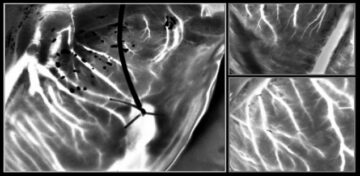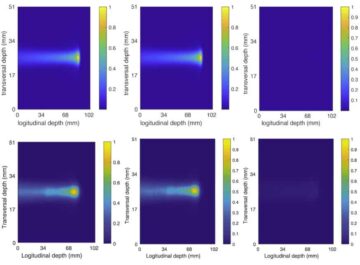Usually, when light travels through a material, it produces an image. But when it passes through a new material developed by researchers at the Australian National University (ANU), it produces two completely independent and different images – as different, in fact, as the iconic outline of the Sydney Opera House and the continent of Australia. This unusual effect is possible thanks to nanoscale structures within the material that manipulate a light wave’s direction of travel in a way that could have applications for information processing and communications.
The nanoscale structures used in this research are ultrathin films comprising arrays of tiny dielectric structures that behave much like atoms. Known as metasurfaces, such structures are often employed in the design of miniaturized optical components, and they can also be used to control the direction in which light can and cannot travel at the nanoscale. For instance, some of these “meta-atoms” allow light to flow only from left to right, while others permit travel only from the right to the left, explains project leader Sergey Kruk of the ANU’s Nonlinear Physics Centre. They can also block the path taken by light in either direction.
Asymmetric images
In the latest work, Kruk and colleagues designed their all-dielectric metasurfaces to interact with light in an asymmetric way. For example, when they shone infrared light through one such structure, an image of Australia appeared in the visible range of the spectrum. When they flipped the metasurfaces around and looked again, they saw instead an image of the Sydney Opera House.
This optical magic trick occurs because of the complex interplay between the material’s nonlinear properties and magneto-electric coupling between artificially-engineered optical modes, Kruk says. “Nonlinear optics studies how materials interact with very bright, high-intensity beams of light, such as those produced by lasers,” he explains. “These nonlinear interactions may be completely different to how weak and moderately bright light (for example, that from the Sun, or from a light bulb) interacts with materials”.
The researchers constructed their metasurfaces from four types of asymmetric non-linear resonators, which are nanocylinders that react to light via the electric dipole and the magnetic dipole. These nanocylinders are composed of two layers of materials, amorphous silicon and silicon nitride, that have different optical constants. In this arrangement, the magneto-electric coupling comes from the asymmetry introduced by the difference in the refractive indices between the two layers.
“Rather like road signs”
The atoms in the metasurface control the flow of light rather like road signs control traffic on a busy road, Kruk says. This ability to guide light at the nanoscale ensures that it “goes where it’s supposed to go and doesn’t go where it’s not supposed to”, he explains.
Such control could have practical applications, Kruk continues. “A wide deployment of tiny components that can control the flow of light could potentially bring technological and social changes similar to transformations brought about in the past by the development of tiny components that control the flow of electricity, which are known as diodes and transistors,” he says.
According to the team, which also includes physicists from Paderborn University in Germany, Southeast University in China and A*STAR Singapore, the metasurfaces could be used in technologies associated with information processing and communication – including the Internet you are probably using to read this article.
“Currently, our information technologies rely heavily on our ability to perform traffic control of electrical currents inside modern computer chips,” Kruk says. “We design and fabricate incredibly sophisticated networks of billions and trillions of semiconductor diodes and transistors that act as road signs and traffic lights for electrical currents, enabling modern computing.

Metasurface laser produces super-twisted light
“Our research suggests it may be possible to control traffic of beams of light similar to how we control electrical currents,” he tells Physics World. “When dealing with information, if we employ beams of light instead of electrical currents, many tasks can be performed faster and more efficiently.”
Preserving the colour of light
In this early-stage work, Kruk and colleagues focused on a nonlinear optical process (known as third harmonic generation) that changes the colour of light. For future applications, however, it might be more useful to stick to a single colour. The researchers say they are therefore working to develop optical nanostructures that preserve colour while displaying similar functionalities. “This will be based on different nonlinear optical phenomena associated with so-called self-action effects,” Kruk reveals. “While nonlinear optics of bulk materials has been well researched, we are only beginning to understand nonlinear optics of materials structured at the nanoscale.”
The work is detailed in Nature Photonics.













